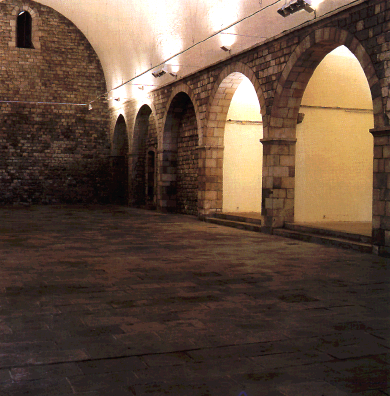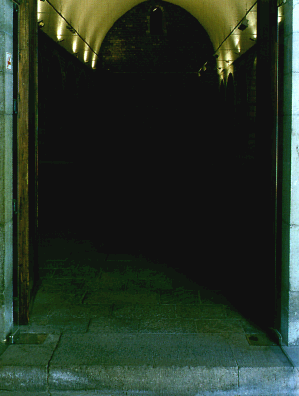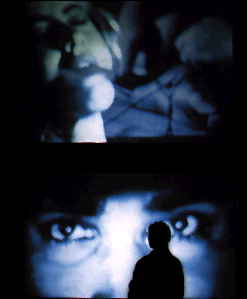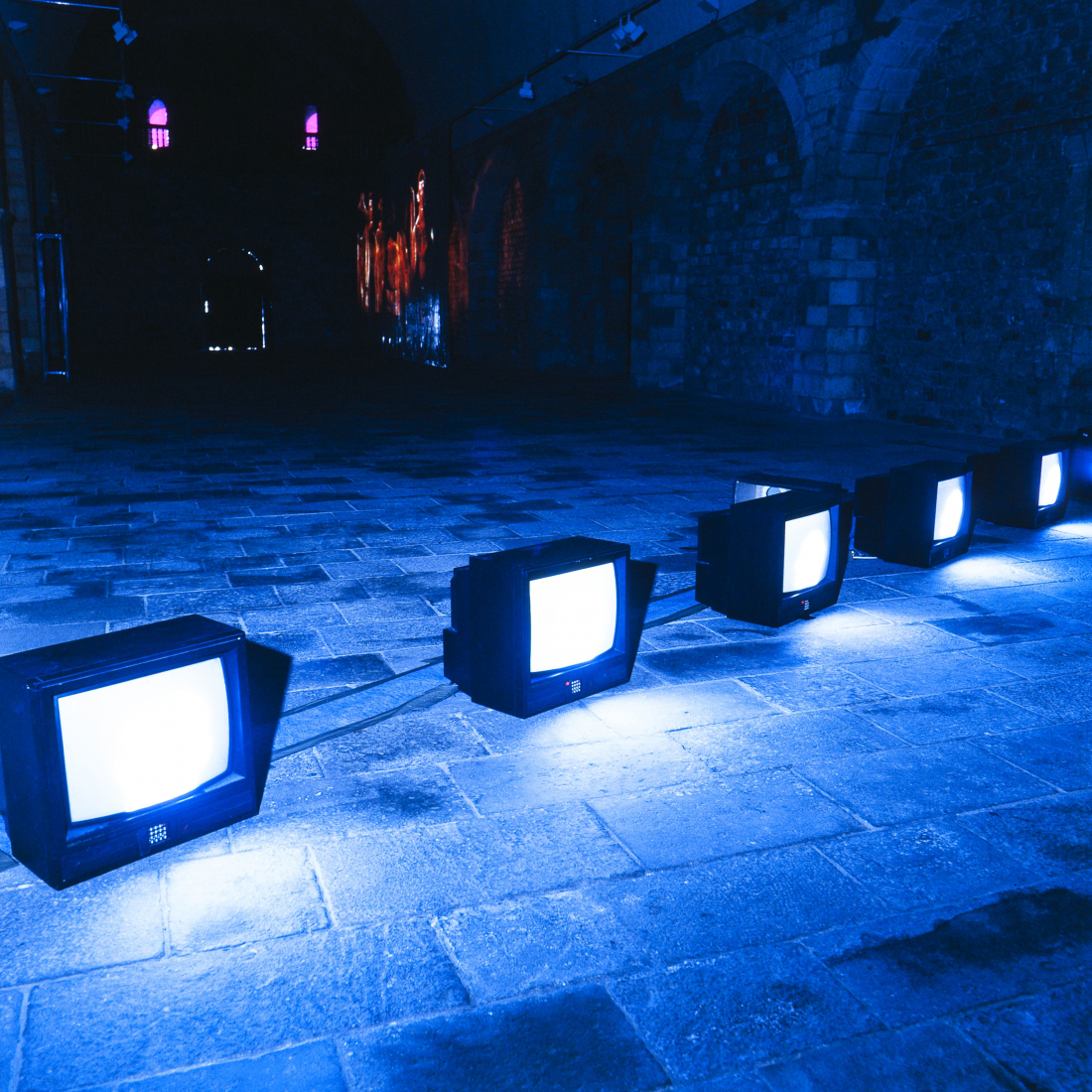Cuando cierres los ojos
Indomesticate the look
The first proposals of Nuria Canal that I saw drew my attention to the naturalness with which they made an essentially critical gesture. Canal silently moved its own private and everyday context to the artistic medium, and managed to keep it unintentionally, as it was, a space of an anodyne, desiccated and common, and on the other hand, habitat and particular. For example, in Installation 001 (1991) the sentimental songs that emitted a radio invaded the space that surrounded a bed halfway. The spontaneity of those fragments of private spaces, such as small metaphors of the truth of things, contrasted timidly but decided with the cultural pretenses of the exhibition spaces and the works that faithfully adapted to the stage decor of the stage. La joie de vivre (1991), a simple photograph of a corner of the kitchen of his house, appeared next to Vista de l'instalation (1991), a large cibachrome. The table, the two chairs and the skins of the protagonists of the first image had lost the carefree and suggestive air and now they put serious action to show the show. Camouflaged in the artist's own eyes, that gesture abiertamente expressed the will to question the "new order of vision" created from the parameters the desire to question the "new order of vision" created from the modernist parameters. This objective shared intentions with the intention of giving a unique role to what Channel defines beautifully as a time never before.
On the other hand, the irony was a game too easy and supposed to establish a disrespectful relationship with the public that the artist never interested him. On the contrary, his work always occurs in an anti-hierarchical voice record and from a frank communicative vocation. What sense would it have, if not, any exposition ritual and work in this field, does Canal ask?
From this awareness of deep discord between the way of understanding their activity and what they demand of cultural standards - value judgments from which interpretative assumptions are imposed on our experience of reality in general and on the production and reception Creative, in particular - they left the following proposals of Channel. The distance towards the normative keys of visuality and the challenge of exposure as one of the mediums where these are often legitimized in the world of art became implicit points of departure in all the projects and explicit in the way it is raises his professional activity.
Canal's bet on the video does not seem to me just accidental. Apart from his own production and participation in video samples, the artist is interested in alternative routes of production and reception outside the deformed cultural channels. In 1992, he created with Toni Serra, an artist who basically works on video, his own signature, << ME PIERDO productions >> and for two years he is co-director of the << Independent Video Show of Brcelona >>, an activity which proposes the dissemination of a wide selection of national and international videos.
As the young story of this medium used by artists suggests since the end of the sixties, this << cultural product >> has always been ambiguously classified in the established media. In fact, the video, as it happened in the middle of the century with photography - and within its scope a certain type of video and photography, little << experimental >> (which does not do the research of the codes of language of artistic interest) -, remains quarantined in the media << approved >>. What is at stake is the privileges acquired through tradition rather than merit of certain artistic languages and, above all, a limited way of understanding contemporary culture. It is no coincidence that some of the most critical proposals about sterility that condemns us to the definition of "culture" in western societies, their institutions and their spokesmen have been made from the video and from the photography As they have often shown a good number of artists of our century the demarcation and defense of a Cultural territory (with capital letters) is one of the strategies of power to preserve the "right" to an authoritarian deal and maintain a relationship father with audiences.
Basic Kit (1994) and Te Sentirás Limpia (1995), their last two videos, are framed, in my opinion, in the long tradition of the video made by women who from the first generations were pioneers in exploring the socio-economic realities , ideologies and policies of culture. Today, it is evident that a significant part of video production by women is dedicated to building new senses in images and discourses and thus to decipher vision models that are assimilated and projected from patriarchy, those that work in the < <elaborated >> cultural standards, this as in the simple patterns by which the culture of masses is governed.
Basic Kit begins with the confession of a woman, a friend of the artist, to another (in this case, we the receivers) of a series of reflections on her sentimental relationship, material that the same artist recorded in the privacy of a private conversation. This voice, off throughout the video, goes into a subtle dialogue with the images of the faces and poses of women recorded in the soap operas, and with the lyrics and music of the same songs from these television series. The affirmations, doubts and questions of this artist's friend propose a nuanced reading of images that, in another context, today, would be discarded quickly as stereotyped.
Channel plays precisely with our reception of this material. Starting from the demonstration of the world of feeling, passion, emotions, weakness, dependence, etc. In a univocal association with the female world, Canal proposes rethinking this relationship in the margin of the inherited meaning schemes. At the same time, it would also be to avoid the trap of investing the point of view by placing it in the victimized world. Therefore, the path is open to another, indomesticated gaze, which would lead us to a new and undoubtably richer, articulated and complex reading of both worlds: emotional and feminine. This is, in fact, one of the key directions of Canal's work, which allows him to go into the fascinating territory of feelings and will, being and speech, of feeling and thinking, of conversation and of language, without having to dissociate them simply as it has often made the dominant point of view (eminently masculine). In this sense, the work Algunas imágenes (1994) is, in my opinion, one of the most brutal and suggestive works. One hundred and sixty-eight first plains of crying women (images of fiction and reality) and a large-sized drama are projected oriented to the outer space of the street. A simple and powerful song, between tribute and claim, to the significant value, in the shade, to the density of one of the most representative gestures of the emotional world.
Sound, often also recorded on television or on the radio, is a leading aspect in Canal's videos. You will feel clean (1995) is the storyline that talks with the images. Again, the artist works from a bombardment of women's images, mainly from well-known TV commercials, from where the title of the video also comes (a well-known catchphrase used for the promotion of female compressions ). In this case, these are women in intricate situations of disorientation, pleasure and anxiety, edited at the pace of thriller. Beyond an interest in analyzing the deconstruction of its subliminal message, there is the intention of a personal, open and creative reading of these images. The idea of enjoying privacy with one's body, of being and feeling self-sufficient, of obtaining a private chamber or a "private moment", (all of them messages originally charged with combative feminism and used today for commercial purposes for advertising), take on the tape a marked sexual character, suggesting scenes of masturbation, sadomasochism, pornography, female voyeurism and scopophilia. From this perspective, the chaining of these scenes connects the idea of "cleanliness" to vision and this to that of pleasure.
At the beginning of the 70's, Laura Mulvey, a film critic and director, investigated from psychoanalysis as cinema << she reflects, reveals and even participates in the correct and socially established interpretation of the sexual difference that controls the images, the erotic forms of watching and the show >>. Mulvey invited in this key article for the theory of art and artistic production to start the feminist project by moving forward << in the understanding of the status quo of the patriarchal order >>. After more than twenty years of proposals in this direction, we can say that Canal's work not only demonstrates the awareness of the operation of these standards in visual language but also offers, as Mulvey proposed, the release of the image of the woman of the symbolic order in which she was trapped, the decoding of the erotic male formulation and the vindication of a diverse and unclassifiable feminine eye (as an agent and as a recipient).
Relationships of affection and love in their broader and more explicitly explained accounts from a strictly personal point of view - their friends and friends - are from a strictly personal point of view - to their friends and friends - they are a fundamental issue in all the work of Canal. For example, the series of photographs is another (1991) in which the artist appears dressed in the clothes with which, as it indicates us, << he had come to recognize a series of women he saw habitually >>; the video titled Apuntes (1994), where his friends and friends walk in front of the camera's eye, an eye that does not flash and allows, in my opinion, an extension of his obsessive gaze of << l the other >> - which is at the same time the eye that looks at herself; Also, Hugs (1996), a series of 15 hug photos with people from their surroundings that portray the special relationship with them and the uniqueness of each of these experiences, and the series Besos, a derivation of this work that is is in process It is important to find out how the artist has chosen a traditionally female theme and, curiously, how the writer Laura Freixes reminds us recently of the magnificent prologue of a story anthology of Spanish writers, devalued as a first-class subject, such as This has been the majority of topics that have been particularly interested in women. With this selection, Canal seems to indicate that it is necessary and critical to read the field of personal relationships of affection and love not as much as the cage where femininity has been relegated but as a privileged area, fortunately for the women in their life and in their production. Without a spirit of universalizing the answers that Channel gives to itself about how things work in this fascinating and complex territory, these amorous situations become the proposal that presents in La Capella the main axis of a new theme.
When you close your eyes (1996) is an audiovisual installation specially made for this impressive architectural work that once was a place where the Catholic liturgy was celebrated. In the central part of the only ship, the artist projects the clear image of open eyes that are located in front of the viewer entering La Capella. In this same space and in a parallel situation, a continuous series of first plans of smiling faces, closed mouths, banded eyes, hands tied, immobilized feet ... evoke states representative of the mechanisms of seduction and domination that act in all relation with another. The images reflect the point of view of domination and of delivery, that of power and that of submission, but blur and confuse the pleasure of power over the other, with that which is achieved in the total delivery and volunteer to the other. The sound, made with the collaboration of the composer Víctor Nubla, is again an element that talks with the images, the spectator and the space. In the side chapels, isolated from the main body, the projections of images - spaces, objects, characters, nature - suggest metaphorically, unlike those of the central nave, the intimate and individual experiences. When you close your eyes, it seems paradoxically invite you to "look," causing a look that does not adapt the eye to the hole in the duchampiana door.







